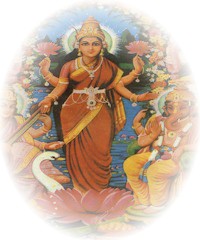 |
 |
| |
| DIWALI
/ DEEPAWALI |
|
| Meaning : A row of lights |
|
| Celebrated
due to : The return of Lord Rama to Ayodhya |
|
| Religion : Hindu |
|
| In the month
of : October - November |
|
|
|
| Diwali, the
festival of lights, comes close on the heels of Dussera (also spelt as Dusshera). In
Andhra Pradesh it is called as "Deepavali". The Goddess of Wealth, Lakshmi, is
the main deity worshipped. Diwali signifies the advent of joy and happiness and is
celebrated for two days. Particularly children await this festival to rejoice with
firecrackers, wear new clothes and savour delicious food. The fun and excitement of
bursting firecrackers by the young and old alike is unimaginable. |
|
| This festival
marks the victory of good over evil and brings along with it glowing happiness and the
touch of sparklers all around. The actual meaning of Diwali is "row of lights".
Diwali is a much-awaited festival for Andhraites, which brings joy and happiness, people
exchange gifts, and decorate their houses. |
 |
|
|
| Factories and
shops remain open on Diwali day and Lakshmi Puja is performed in the evenings. It is
believed that Goddess Lakshmi graces the shops and houses on this day and showers her
blessings and bestows good fortune upon her worshippers. There seems to be a change in the
perception of lifestyles of people over the years, they are growing conscious of
possessing new acquisitions. They started using candles and electrical lighting instead of
traditional earthenware lamps. |
|
Legend Behind The Festival
The legend behind these celebrations goes like this, Narakasura, a monster, ruled the
kingdom of Pradyoshapuram. He was a troublemaker to the gods and the pious sages, causing
disturbance to their penance and creating havoc during the rituals. To prove his power,
Narakasura usurped some territory of Aditi, the king of Suraloka and a relative of
Satyabhama, Lord Krishna's wife. He also abducted 16,000 women and imprisoned them in his
palace. Vexed with this harassment, the gods led by Indra approached Lord Krishna and
pleaded him to protect them from the demon "Narakasura". |
|
| Satyabhama was
enraged by Narakasura's malevolence towards women and appealed to Krishna to give her
golden chance to destroy Narakasura. The legend also says that Narakasura was given a
curse that a woman would kill him. Krishna granted Satyabhama a boon to fight with
Narakasura. |
|
| Satyabhama
entered the battlefield, with Krishna as her charioteer. During the war, Krishna swooned
for a while, a preordained divinely act adopted to empower Satyabhama to kill the demon,
Narakasura. The imprisoned women were released after Narakasura was beheaded. The killing
of Narakasura was a victory of good over evil. It is interesting to note that Bhudevi,
mother of the slain Narakasura, declared that his death should not be a day of mourning
but an occasion to celebrate and rejoice. Since then, Diwali is celebrated every year on
this day with a lot of fun and frolic and by burning of fireworks. |
|
The Festivity
Celebrations on Diwali begin at dawn as early as around three in the morning, the family
members are given an oil massage, followed by 'Aarti' and then the children burst crackers
to mark the joyous day. |
|
| At dusk when
darkness unfolds itself, you can see a spectacular illumination of tiny flickering lamps
adorning in rows - at homes, buildings and streets. Multicoloured and noisy firecrackers
are burst with enthusiasm both by young and old. From simple coloured sparklers, pencils,
flowerpots, ground 'Chakras' (wheels), Vishnu Chakras, and rockets to the long 'Ladi' /
garland crackers, one has got a wide range to choose from. |
|
|
|
|
|
|
|
 |
 |
|
 |
 |
| |
 |
 |
|